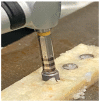Spectrometric Analysis of the Wear from Metallic and Ceramic Dental Implants following Insertion: An In Vitro Study
- PMID: 35161144
- PMCID: PMC8838065
- DOI: 10.3390/ma15031200
Spectrometric Analysis of the Wear from Metallic and Ceramic Dental Implants following Insertion: An In Vitro Study
Abstract
Titanium wear is a growing area of interest within dental implantology. This study aimed to investigate titanium and zirconium wear from dental implants at the time of insertion using X-ray-fluorescence spectrometry (XRF) and an in vitro protocol utilizing artificial bovine bone plates. Five groups were analyzed using XRF-spectrometry: groups 1-4 (titanium implants) and group 5 (zirconia implants). The implants were inserted into two bone blocks held together by a vice. The blocks were separated, and the insertion sites were analyzed for titanium (Ti) and zirconium (Zr). Statistical descriptive analyses of Ti and Zr concentrations in the coronal, middle and apical bone interface were performed. A comparative analysis confirmed differences between the implant's surface stability and Ti accumulation within the insertion sites of the bone block. There was a direct relationship between implant length and the quantity of titanium found on the bone block. The data generally indicates greater quantities of titanium in the coronal thirds of the implants, and less in the apical thirds. The titanium and zirconium found in the bone samples where the group 5 implants were inserted was not of statistical significance when compared to control osteotomies. The results of this study confirm wear from metallic, but not ceramic, dental implants at the time of insertion.
Keywords: metals; peri-implantitis; titanium; wear; zirconia.
Conflict of interest statement
The authors declare no conflict of interest.
Figures




Similar articles
-
Wear and Corrosion Interactions at the Titanium/Zirconia Interface: Dental Implant Application.J Prosthodont. 2018 Dec;27(9):842-852. doi: 10.1111/jopr.12769. Epub 2018 Mar 9. J Prosthodont. 2018. PMID: 29521461
-
Evaluation of insertion torque and surface integrity of zirconia-coated titanium mini screw implants.J World Fed Orthod. 2020 Mar;9(1):13-17. doi: 10.1016/j.ejwf.2020.01.002. Epub 2020 Feb 13. J World Fed Orthod. 2020. PMID: 32672662
-
Wear at the titanium-titanium and the titanium-zirconia implant-abutment interface: a comparative in vitro study.Dent Mater. 2012 Dec;28(12):1215-20. doi: 10.1016/j.dental.2012.08.008. Epub 2012 Sep 27. Dent Mater. 2012. PMID: 23021964
-
Differences in Titanium, Titanium-Zirconium, Zirconia Implants Treatment Outcomes: a Systematic Literature Review and Meta-Analysis.J Oral Maxillofac Res. 2023 Sep 30;14(3):e1. doi: 10.5037/jomr.2023.14301. eCollection 2023 Jul-Sep. J Oral Maxillofac Res. 2023. PMID: 37969951 Free PMC article. Review.
-
Clinical Performance Comparing Titanium and Titanium-Zirconium or Zirconia Dental Implants: A Systematic Review of Randomized Controlled Trials.Dent J (Basel). 2022 May 12;10(5):83. doi: 10.3390/dj10050083. Dent J (Basel). 2022. PMID: 35621536 Free PMC article. Review.
Cited by
-
Silk Fibroin/ZnO Coated TiO2 Nanotubes for Improved Antimicrobial Effect of Ti Dental Implants.Materials (Basel). 2023 Aug 26;16(17):5855. doi: 10.3390/ma16175855. Materials (Basel). 2023. PMID: 37687548 Free PMC article.
-
Titanium micro-particles are commonly found in soft tissues surrounding dental implants.Commun Med (Lond). 2025 Mar 18;5(1):78. doi: 10.1038/s43856-025-00756-3. Commun Med (Lond). 2025. PMID: 40102654 Free PMC article.
References
-
- Misch C.E., Perel M.L., Wang H.-L., Sammartino G., Galindo-Moreno P., Trisi P., Steigmann M., Rebaudi A., Palti A., Pikos M.A., et al. Implant success, survival, and failure: The International Congress of Oral Implantologists (ICOI) pisa consensus conference. Implant Dent. 2008;17:5–15. doi: 10.1097/ID.0b013e3181676059. - DOI - PubMed
LinkOut - more resources
Full Text Sources

